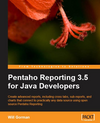Experimental Action Editor in GWT
I wanted to share with everyone a new open source project that I just released out to Google Code. When using Pentaho’s BI Server, users create Action Sequences to pull their data from a warehouse and display it in a Report, etc. Pentaho’s Action Sequences make it easy for business analysts to define their own process. Pentaho offers Action Components ranging from Analysis OLAP Views to XML Queries that can be combined to create an Action Sequence. Today, you can use one of our many wizards to generate an Action Sequence, or generate one with our Design Studio, a thick client application built on Eclipse.
To educate myself in Google’s Web Toolkit (GWT), I decided to attempt a port of our Design Studio over to thin client. I’ve made a lot of progress, including getting Dom4J running in GWT along with Pentaho’s Action Sequence DOM, an important library that parses and builds a document object model of an Action Sequence file. This week I’ve uploaded the first set of code, which implements input, resource and output parameter management, as well as the start of a couple Action Components, including SQL Lookup Rule and the JFreeReport Component. The project includes instructions to integrate into our latest BI Server, so you can right click, select “Edit Action”, and start editing your Action Sequence right in the browser!
If there are folks out there interested in contributing to this project, please feel free to check out the code, help out with requirements, graphics, you name it! I’ll be working on the project in my spare time.
DOM4J4GWT
This is a light DOM4J Implementation, designed to run within GWT’s client environment
http://code.google.com/p/dom4j4gwt
Penaho Action Sequence DOM 4 GWT
This project modifies Pentaho Action Sequence DOM so that it may run within GWT’s client environment
http://code.google.com/p/pentaho-actionsequence-dom-4gwt
Pentaho Action Editor
This is the main project, that allows you to edit Pentaho’s Action Sequences in the browser. It includes instructions for deploying into Pentaho’s 2.0 BI Platform
http://code.google.com/p/pentaho-actioneditor
 Comments(0)
Comments(0)